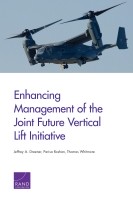| 来源类型 | Research Reports
|
| 规范类型 | 报告
|
| DOI | https://doi.org/10.7249/RR2010
|
| ISBN | 9780833098375
|
| 来源ID | RR-2010-OSD/JS
|
| Enhancing Management of the Joint Future Vertical Lift Initiative |
| Jeffrey A. Drezner; Parisa Roshan; Thomas C. Whitmore
|
| 发表日期 | 2017
|
| 出版年 | 2017
|
| 页码 | 122
|
| 语种 | 英语
|
| 结论 |
- Joint management and commonality are not the same. Joint management is an organizational construct established to jointly manage a program with multiple participants. In contrast, commonality is a technical design concept in which different systems use the same components or subsystems. In general, it is commonality (in some form) that is responsible for cost savings or other benefits that are attributed to joint management. Commonality may emerge organically (bottom-up) and be managed successfully without a formal joint management construct.
- Voluntary participation is a key enabler of successful joint initiatives. This ensures that participants are self-motivated and self-organizing.
- Requirements must be substantially the same across all stakeholders. This means that the basic technical characteristics of the system (or subsystems and components) must be similar enough that compromises to accommodate diverse requirements do not impose additional costs (in dollars, risk, or performance) on the system. This is extremely challenging for a complex multiservice weapon system program, but it may be somewhat more manageable at the subsystem or component level.
- Any formal joint or multiservice management construct should be founded on comprehensive planning, which includes delineating the roles, responsibilities, and authorities or participants; decision and oversight processes; and other rules of engagement. These should be codified in a memorandum of agreement.
- The specific advantages and disadvantages — benefits and costs — of each management construct are contingent on a clear definition of exactly what is being acquired and by whom, as well as the business, organizational, and budgetary environment in which they are operating in.
|
| 摘要 |
- The FVL should not implement a purely joint construct at this time. There is no evidence that joint management produces net benefits for a complex program, let alone a series of complex programs, as envisioned in the FVL family of systems (FoS).
- The FVL should take advantage of the opportunity to more fully explore management constructs for commonality, analyze the key actions or decisions that generate commonality, and better understand the costs and benefits of commonality by including such an analysis as part of the upcoming analysis of alternatives.
- Any future FVL management construct should use existing organizations, authorities, and processes to the maximum extent possible.
- The attributes and enablers of successful joint management discussed in this report should also be followed as much as possible, meaning designed into the planning and implementation of the management construct.
- A parallel development approach to common systems should be considered — the intentional separation of both technology development and management of major subsystems or components — given the complexity of the FVL FoS and the long period over which its programs will be active and operational.
- The decades-long time frame of the FVL FoS also suggests that any management constructs should incorporate the attributes of learning organizations, which are open systems that adapt and thrive in changing environments.
- The FVL community should identify the key framing assumptions that underlie the FVL FoS concept. Framing assumptions can have a significant adverse effect on program cost, schedule, and performance outcomes.
|
| 主题 | Military Acquisition and Procurement
; Military Aircraft
; Military Budgets and Defense Spending
|
| URL | https://www.rand.org/pubs/research_reports/RR2010.html
|
| 来源智库 | RAND Corporation (United States)
|
| 引用统计 |
|
| 资源类型 | 智库出版物
|
| 条目标识符 | http://119.78.100.153/handle/2XGU8XDN/108541
|
推荐引用方式
GB/T 7714 |
Jeffrey A. Drezner,Parisa Roshan,Thomas C. Whitmore. Enhancing Management of the Joint Future Vertical Lift Initiative. 2017.
|
|
文件名:
|
x1502719324255.jpg
|
|
格式:
|
JPEG
|

|
文件名:
|
RAND_RR2010.pdf
|
|
格式:
|
Adobe PDF
|
除非特别说明,本系统中所有内容都受版权保护,并保留所有权利。